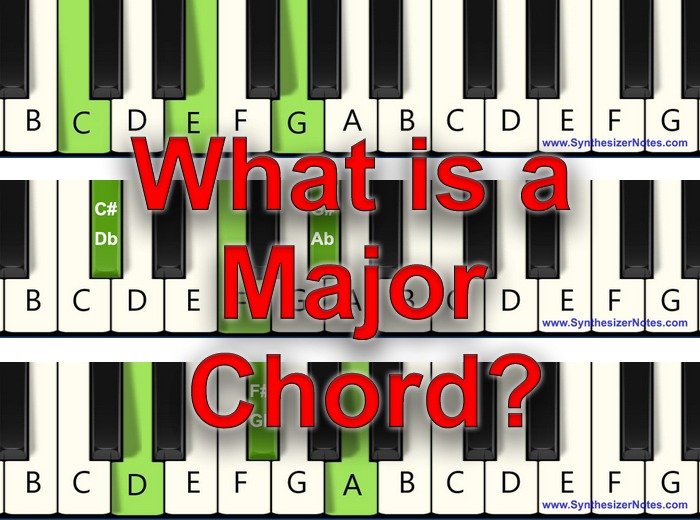Major Chords Made Easy (With Pics!)
Have you ever wondered what makes a major chord sound so bright and uplifting? How are those bright, happy-sounding chords made?
In this post, we’ll dive into the world of major chords, uncovering their building blocks and various methods for constructing them.

So, get ready to unlock their secrets and learn everything you need to start using them in your music.
We will also discuss various simple ways to construct a major chord (no complex theory needed!), so you can easily find them on any instrument, and also a handy cheat-sheet of all major chords with images.
We will cover the following topics on major chords:
- What is a major chord?
- What are the building blocks of a major chord?
- Different ways to construct a major chord
- A list of all major chords with images for each chord
What is a Major Chord?
Major chords are triads, meaning they consist of three notes.
A major chord is a combination of three notes played together – the root, the major third, and the perfect fifth. In piano, a major chord is typically played by simultaneously pressing down the keys corresponding to these three notes.
Major chords generally sound bright, happy, and cheerful.
The Building Blocks of a Major Chord?
Here’s how a major chord is constructed:
Root note
The base of the chord (e.g., C in a C Major chord).
The root of the chord determines its name and is the note from which the chord is built. For example, in a C major chord, the note C is the root.
Major Third
Four half steps (two whole steps) above the root note.
The major third is an interval of two whole steps (or four half steps) above the root note.
In a C major chord, the major third is E.
Perfect Fifth
Seven half steps (three and a half whole steps) above the root note.
The perfect fifth is an interval of three and a half steps (or seven half steps) above the root note.
In a C major chord, the perfect fifth is G.
So, a C major chord on the piano consists of the notes C, E, and G played together.
Major chords are fundamental to Western music harmony and are used extensively in various musical genres, from classical to pop to jazz. They form the basis of many songs and are essential for piano players to learn and understand.
List of Major Chords with Images
C major
C – E – G
As shown in the following image, C major chord is made from keys C, E and G, where C is the root note, E is the major third, which is 2 whole step after C note and G is the perfect fifth which is 1 and half note after E.

C# major / Db major
C sharp major:
C# – E# (F) – G#
D flat major:
Db – F – Ab

D major:
D – F# – A

D# major / Eb major
D sharp major:
D# – G – A#
E flat major:
Eb – G – Bb

E major:
E – G# – B

F major:
F – A – C

F# major / Gb major
F sharp major: F# – A# – C#
G flat major: Gb – Bb – Db

G major:
G – B – D

G# major / Ab major
G sharp major: G# – B# (C) – D#
A flat major: Ab – C – Eb

A major:
A – C# – E

A# major / Bb major
A sharp major:
A# – C## (D) – E# (F)
B flat major:
Bb – D – F

B major:
B – D# – F#

Different Ways to Construct a Major Chord
There are many different ways to conceptualize and construct major chords. We have given 4-5 different ways to construct a major chord, so you can select the method that best suits your needs.
- Using Whole and Half Steps
- Using Half Steps Alone:
- Using Key Numbers on a Keyboard – 1
- Using Key Numbers on a Keyboard – 2
- Using the Difference in Keys
Experimenting with each method can deepen understanding and proficiency in playing major chords on the piano.
Using Whole and Half Steps
A major chord is made of a root note, a note that is a major third above the root, and a note that is a perfect fifth above the root.
A major third is two whole steps (4 half steps) above the root.
A perfect fifth is three and a half whole steps (7 half steps) above the root.
Example: C Major Chord
- Root: C
- Major Third: E (two whole steps above C)
- Perfect Fifth: G (three and a half whole steps above C)
Using Half Steps Alone
A major third is four half steps above the root.
A perfect fifth is seven half steps above the root.
Example: C Major Chord
- Root: C
- Major Third: E (four half steps above C)
- Perfect Fifth: G (seven half steps above C)
Using Key Numbers on a Keyboard – 1 (1, 5, 8)
Think of a standard piano keyboard
Each key (white or black) represents a unique note with a number.
To form a major chord, consider your root note as the first key:
So, Root note as 1
Major third will be 5
and the Perfect fifth will be 8
Example: C Major Chord
- Root: C (Kwy Number 1)
- Major Third: Key Number 5 (This will be E)
- Perfect Fifth: Key number 8 (This will be G)
Using Key Numbers on a Keyboard – 2 (1, +4, +7)
Think of a standard piano keyboard
Each key (white or black) represents a unique note with a number.
To form a major chord, take your root note’s key number and add these:
+4 for the major third
+7 for the perfect fifth
Example: C Major Chord
- Root: C (Find its key number)
- Major Third: C key number + 4 (This will be E)
- Perfect Fifth: C key number + 7 (This will be G)
Using the Difference in Keys
This method is like #3, but focuses on the spaces between keys.
From the root, the major third is 4 keys away
From the root, the perfect fifth is 7 keys away
Example: C Major Chord
- Root: C
- Major Third: Count 4 keys to the right (This is E)
- Perfect Fifth: Count 7 keys to the right (This is G)
Summary
A major chord in piano is a combination of three notes played simultaneously, consisting of a root note, a major third above the root, and a perfect fifth above the root.
- Root: The base note that gives the chord its name (e.g., C in a C major chord).
- Major Third: Four half steps above the root note (e.g., E in a C major chord).
- Perfect Fifth: Seven half steps above the root note (e.g., G in a C major chord).
Major chords are associated with a bright, happy, and uplifting sound.



